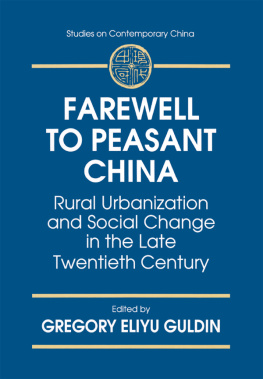MIGRATION AND URBANIZATION IN CHINA
Environmental Studies/Asia
Patterns of migration in China since the establishment of the Peoples Republic have differed considerably from those in other countries. Three features are of particular note: the extent of government intervention in the process, the uncertainty concerning magnitude (owing to ambiguous definitions), and the prominent role played by temporary movement.
Based on a careful analysis of the large-scale national survey of migration conducted in late 1986 by the Chinese Academy of Social Sciences with partial support from the U.N. Fund for Population Activities, this book provides detailed analyses of the volume and direction of movement, the characteristics and motivations of those who move, and the consequences of their moving. There is also thorough discussion of the complex issues surrounding the definition of permanent and temporary migration and their pattern and significance.
STUDIES IN CHINESE ENVIRONMENT AND DEVELOPMENT
A Monograph Series
Edited by Shiu-hung Luk and Joseph Whitney
With one-fifth of the worlds population concentrated in about eight percent of the land surface, Chinas impact on her own territory throughout history has always been of a magnitude seen in few other regions. Now that China has embarked on a path of rapid economic development largely fueled by abundant resources of coal, the impact on her own land and on the globe as a whole is substantial and will increase over the coming decades. A deteriorating environment will have repercussions both on the global economy as well as on Chinas own progress as pollution and natural hazards intensify and increase the costs of development.
With contributions by scholars from China and abroad, this Monograph Series will explore in a holistic way, consistent with the complex ecosystem phenomena involved, the relationships between environment and development in Chinas past and present. This will provide valuable insights into the countrys future not found in other scholarly publications.
An East Gate Book
First published 1994 by M.E. Sharpe.Inc
Published 2016 by Routledge
2 Park Square, Milton Park, Abingdon, Oxon OX14 4RN
711 Third Avenue, New York, NY 10017, USA
Routledge is an imprint of the Taylor & Francis Group, an informa business
Copyright 1994 by Taylor & Francis. All rights reserved.
No part of this book may be reprinted or reproduced or utilised in any form or by any electronic, mechanical, or other means, now known or hereafter invented, including photocopying and recording, or in any information storage or retrieval system, without permission in writing from the publishers.
Notices
No responsibility is assumed by the publisher for any injury and/or damage to persons or property as a matter of products liability, negligence or otherwise, or from any use of operation of any methods, products, instructions or ideas contained in the material herein.
Practitioners and researchers must always rely on their own experience and knowledge in evaluating and using any information, methods, compounds, or experiments described herein. In using such information or methods they should be mindful of their own safety and the safety of others, including parties for whom they have a professional responsibility.
Product or corporate names may be trademarks or registered trademarks, and are used only for identification and explanation without intent to infringe.
Library of Congress Cataloging-in-Publication Data
Migration and urbanization in China / Lincoln H. Day and Ma Xia, editors.
p. cm.(Studies in Chinese environment and development)
An East Gate book
Includes bibliographical references and index.
ISBN 1-56324-338-5
1. Rural-Urban migrationChina.
2. Migration, InternalChina.
3. UrbanizationChina.
4. ChinaEconomic conditions1976 .
5. ChinaPopulation.
I. Day, Lincoln H., 1928 .
II. Ma, Xia, 1924 .
III. Series.
HB19551993
307.241760951dc20
93-29350
CIP
ISBN 13: 978-1-56324-338-7 (hbk)
Lincoln H. Day
This collection consists of papers based on data derived from a large-scale survey, conducted in late 1986, of urban migration in China. Two subsequent inquiries a one per cent sample survey of the entire population, taken in 1987 (China, State Statistical Bureau, 1988), and a national census (China, National Population Census Office, 1991), taken in 1990 cover some of the same ground, but neither of these has the historical depth of the 1986 survey or its socioeconomic detail relevant to the study of urban migration. As a source of information on urban migration, the 1986 survey is unique.
Although a majority of its people are still essentially rural, China now has, by whatever definition (and current definitions vary greatly), the largest urban population in the world. Thus, how the Peoples Republic deals with issues like urban housing, transportation, sanitation, and security will necessarily affect the welfare of vast numbers of people (see Table A). It is not beyond reason to suppose that it might also provide important lessons for other low-income countries.
That there are massive numbers of urban migrants in China should come as no surprise. Not only is Chinas major urban development of recent origin but, in a population of more than a billion, even a modest demographic phenomenon will directly involve tens of millions and recent urban migration in China has not been a modest phenomenon.
Irrespective of its magnitude, however, the pattern of this migration has differed markedly from comparable patterns elsewhere. Three of its features during the period since establishment of the Peoples Republic are of particular note: (a) the extent of governmental intervention in the process, (b) the uncertainty concerning its magnitude owing to the uniqueness of the definitions employed for such fundamental concepts as migrant and nonmigrant, temporary migration and permanent migration, and (c) the prominent role played by temporary movement.
TABLE A


 AND DEVELOPMENT
AND DEVELOPMENT









